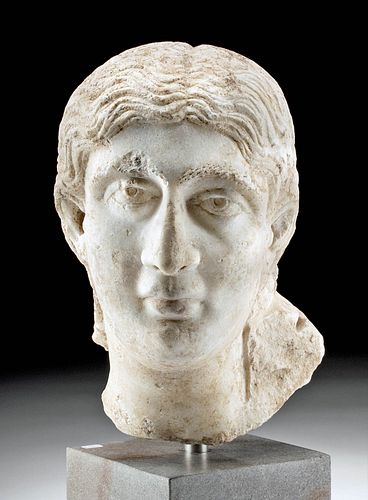Beautiful Roman Marble Head of a Woman w/ Hairnet
Lot 70
About Seller
Artemis Fine Arts
686 S Taylor Ave, Ste 106
Louisville, CO 80027
United States
Selling antiquities, ancient and ethnographic art online since 1993, Artemis Gallery specializes in Classical Antiquities (Egyptian, Greek, Roman, Near Eastern), Asian, Pre-Columbian, African / Tribal / Oceanographic art. Our extensive inventory includes pottery, stone, metal, wood, glass and textil...Read more
Estimate:
$16,000 - $24,000
Absentee vs Live bid
Two ways to bid:
- Leave a max absentee bid and the platform will bid on your behalf up to your maximum bid during the live auction.
- Bid live during the auction and your bids will be submitted real-time to the auctioneer.
Bid Increments
| Price | Bid Increment |
|---|---|
| $0 | $25 |
| $300 | $50 |
| $1,000 | $100 |
| $2,000 | $250 |
| $5,000 | $500 |
| $10,000 | $1,000 |
| $20,000 | $2,500 |
| $50,000 | $5,000 |
| $100,000 | $10,000 |
| $200,000 | $20,000 |
About Auction
By Artemis Fine Arts
Oct 7, 2021
Set Reminder
2021-10-07 10:00:00
2021-10-07 10:00:00
America/New_York
Bidsquare
Bidsquare : Exceptional Antiquities Ethnographic Fine Art
https://www.bidsquare.com/auctions/artemis-gallery/exceptional-antiquities-ethnographic-fine-art-7537
Museum-worthy examples of Egyptian, Greek, Roman, Etruscan, Near Eastern, Far East / Asian, Pre-Columbian, African / Tribal, Oceanic, Native American, Spanish Colonial, Fossils, Ancient Jewelry, Fine / Visual Arts, so much more! Artemis Fine Arts info@artemisgallery.com
Museum-worthy examples of Egyptian, Greek, Roman, Etruscan, Near Eastern, Far East / Asian, Pre-Columbian, African / Tribal, Oceanic, Native American, Spanish Colonial, Fossils, Ancient Jewelry, Fine / Visual Arts, so much more! Artemis Fine Arts info@artemisgallery.com
- Lot Description
Roman, Imperial Period, ca. 3rd to 4th century CE. An exemplary marble head of a woman frozen forever in an expression that suggests a quiet thoughtfulness and silent observation. Breathtakingly life-like, the ancient beauty presents a sultry stare, gazing forward from large, hooded eyes with incised pupils below arched brows, meticulously carved to show each hair. Her youthful countenance further displays a naturalistic nose with a narrow bridge and broad nostrils, set above a petite pair of bow-shaped, pursed lips and a round chin. Centrally parted, her skillfully sculpted coiffure perfectly frames her sweet visage, with her wavy locks falling just behind her ears and held back behind her head in a lattice-form hairnet. Note the artist's expert ability to render flesh from stone as evident in the softness of her cheeks and silky smoothness of her skin. A mesmerizing example from the ancient Roman world, replete with artistic virtuosity! Size: 8.3" L x 7.1" W x 11.9" H (21.1 cm x 18 cm x 30.2 cm); 15.4" H (39.1 cm) on included custom stand.
The hair style is the clue to the age of this piece. From the 3rd century CE onward, Roman sculptors commonly began to use running drills for decorative effects. Holding a wooden support in one hand to guide the drill bit, the sculptor would drill into the surface at a 30-to-45-degree angle, repeatedly lifting and moving the drill to create a series of holes at a shallow angle to the surface of the stone, creating the appearance of a channel, as you can see here with the wavy effect used to create the hair. The eyes also have noticeable drill marks. This is not only a beautiful piece, but also demonstrates the skill and tools of Roman artists.
Marble statuary was everywhere in ancient Rome; even after all of the plundering that Rome underwent after the fall of the Roman Empire, we can still see a tremendous amount of marble statuary, including friezes, busts, and full body statues, throughout the city. As a Roman citizen, you would have seen a world decorated with sculpted pieces like this one; they would have been brightly colored, gilded, or given inlays of shell or other stone. Today, with age taking them down to their original stone, they have attained a solemn, timeless look.
This piece has been searched against the Art Loss Register database and has been cleared. The Art Loss Register maintains the world's largest database of stolen art, collectibles, and antiques.
Provenance: East Coast collection, New York Gallery, New York City, New York, USA, before 2010
All items legal to buy/sell under U.S. Statute covering cultural patrimony Code 2600, CHAPTER 14, and are guaranteed to be as described or your money back.
A Certificate of Authenticity will accompany all winning bids.
PLEASE NOTE: Due to recent increases of shipments being seized by Australian & German customs (even for items with pre-UNESCO provenance), we will no longer ship most antiquities and ancient Chinese art to Australia & Germany. For categories of items that are acceptable to ship to Australia or Germany, please contact us directly or work with your local customs brokerage firm.
Display stands not described as included/custom in the item description are for photography purposes only and will not be included with the item upon shipping.
#157783Fragment of a larger piece. Chipping to proper right eyebrow. Expected surface wear with some minor nicks, abrasions, and scratches throughout. Some light softening of detail on hair and ears. Otherwise, excellent with remarkable preservation of facial details.Condition
- Shipping Info
-
All shipping is handled in-house for your convenience. Your invoice from Artemis Gallery will include shipping calculation instructions. If in doubt, please inquire BEFORE bidding for estimated shipping costs for individual items.
-
- Buyer's Premium



 EUR
EUR CAD
CAD AUD
AUD GBP
GBP MXN
MXN HKD
HKD CNY
CNY MYR
MYR SEK
SEK SGD
SGD CHF
CHF THB
THB














